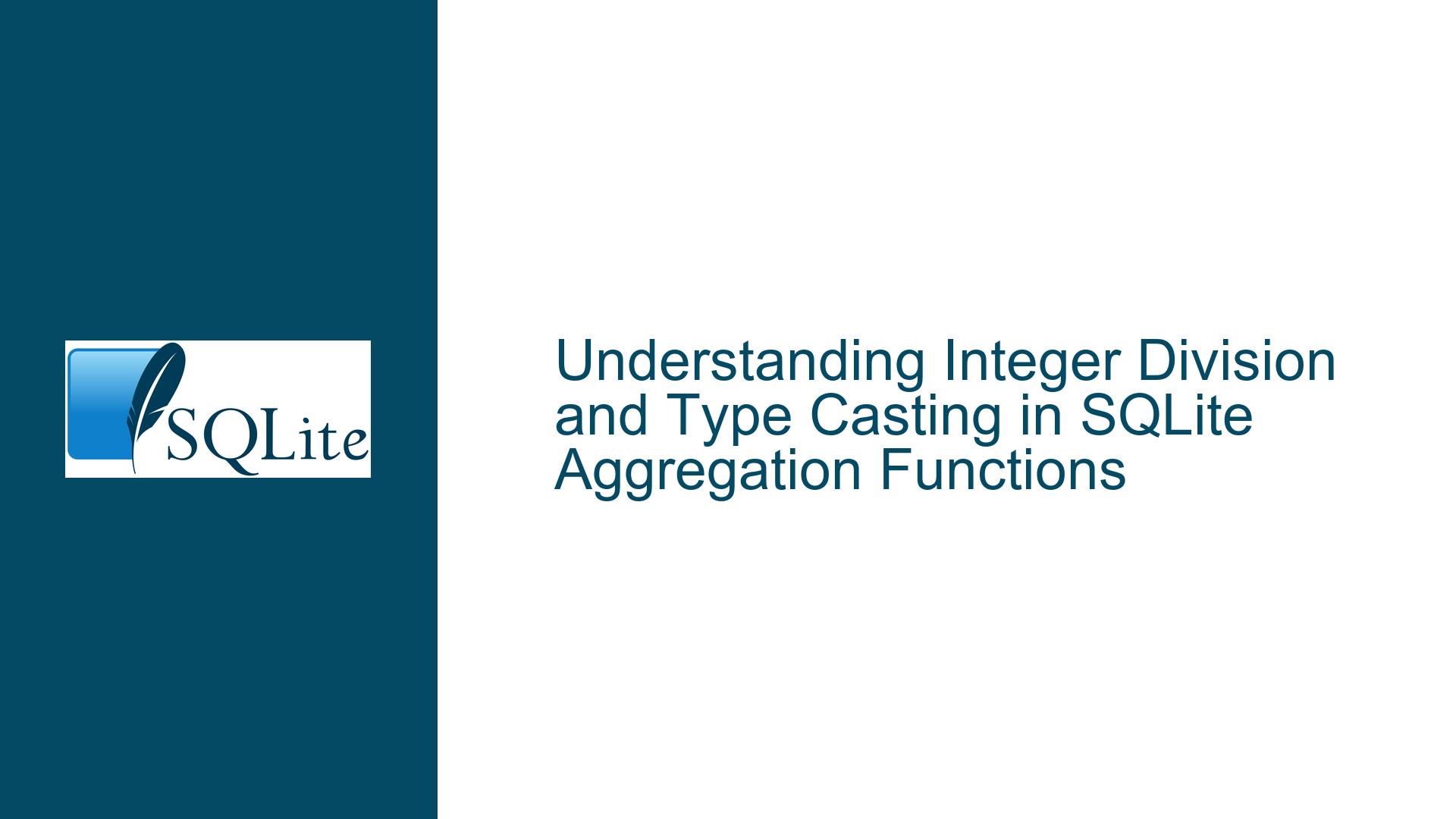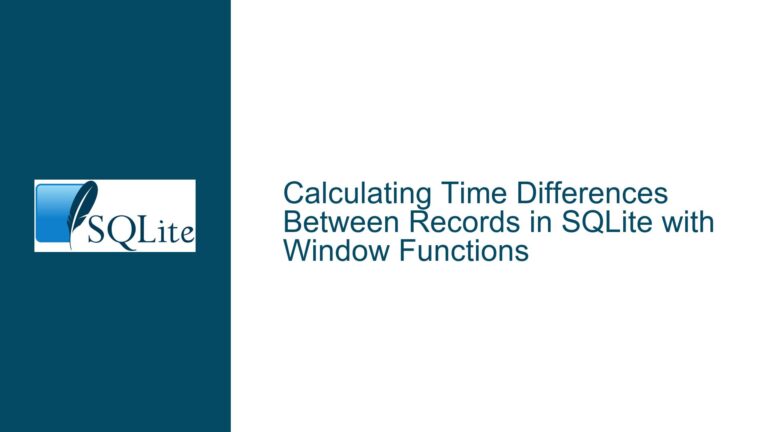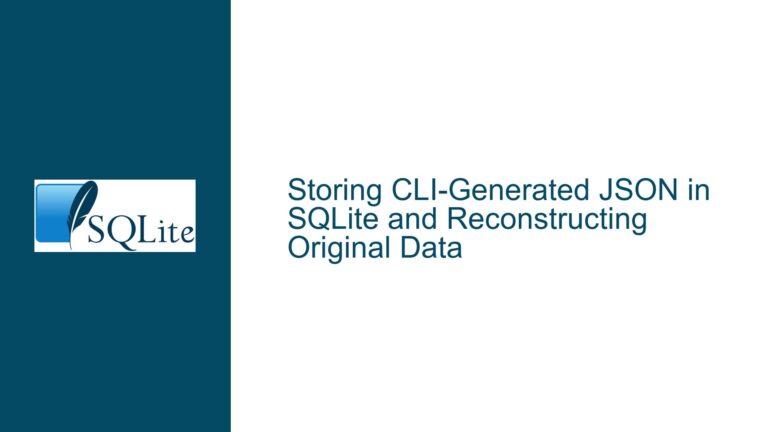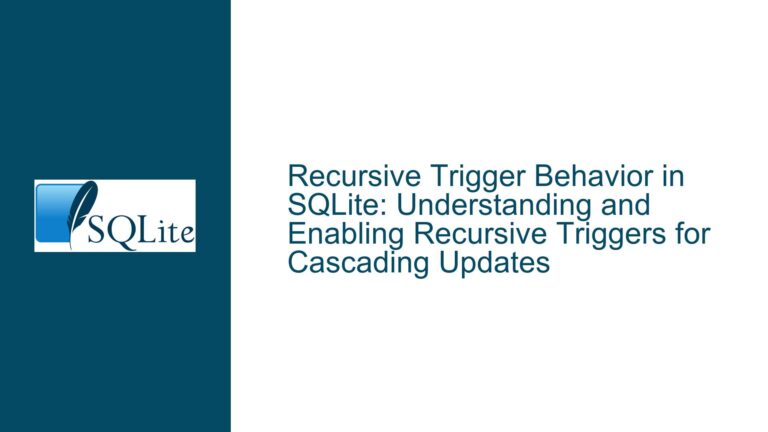Integer Division and Type Casting in SQLite Aggregation Functions
Issue Overview: Unexpected Zero Results in Division Involving SUM() and Views
When working with SQLite, particularly in scenarios involving aggregation functions like SUM() and views, unexpected results can arise due to the way SQLite handles data types during arithmetic operations. A common issue occurs when performing division operations where both the numerator and denominator are integers, leading to integer division. This can result in a zero value when the numerator is smaller than the denominator, which might not be the intended outcome.
In the provided scenario, the user encountered a situation where the margin_pct column in a view returned zero unless the SUM() function was wrapped in a ROUND() function. This behavior is not a bug but rather a consequence of SQLite’s type handling and integer division rules. The SUM() function in SQLite returns an integer if all the values in the column are integers, and when this integer is divided by another integer, SQLite performs integer division, which truncates the decimal part, potentially resulting in zero.
Possible Causes: Integer Division and Type Handling in SQLite
The core issue stems from SQLite’s handling of data types during arithmetic operations. SQLite is a dynamically typed database, meaning that the data type of a value is associated with the value itself, not the column it is stored in. This flexibility can lead to unexpected behavior when performing arithmetic operations, especially division.
When the SUM() function is used on a column containing only integers, the result is also an integer. If this integer result is then used in a division operation with another integer, SQLite performs integer division. Integer division truncates the fractional part of the result, which can lead to a zero value if the numerator is smaller than the denominator.
For example, consider the following query:
SELECT (SELECT SUM(proportion) FROM votes WHERE party = 'a') / SUM(proportion) FROM votes;
If the SUM(proportion) for party ‘a’ is 60 and the total SUM(proportion) is 165, the result of the division 60 / 165 would be 0 in integer division, as the fractional part (0.3636…) is truncated.
This behavior is consistent with standard SQL practices, where integer division results in an integer. However, it can be counterintuitive for users expecting floating-point division, especially when working with percentages or ratios.
Troubleshooting Steps, Solutions & Fixes: Ensuring Floating-Point Division in SQLite
To avoid the pitfalls of integer division in SQLite, several strategies can be employed to ensure that division operations yield the expected floating-point results. These strategies involve manipulating the data types of the operands to force floating-point division.
1. Using the TOTAL() Function Instead of SUM()
The TOTAL() function in SQLite always returns a floating-point number, regardless of the input data types. This makes it a suitable alternative to SUM() when performing division operations, as it ensures that the result is a float, thus avoiding integer division.
SELECT (SELECT TOTAL(proportion) FROM votes WHERE party = 'a') / TOTAL(proportion) FROM votes;
In this query, both the numerator and denominator are guaranteed to be floating-point numbers, ensuring that the division operation yields a floating-point result.
2. Explicit Type Casting with CAST()
Another approach is to explicitly cast the result of the SUM() function to a floating-point type using the CAST() function. This forces SQLite to treat the result as a float, ensuring that the division operation is performed in floating-point arithmetic.
SELECT (SELECT CAST(SUM(proportion) AS REAL) FROM votes WHERE party = 'a') / CAST(SUM(proportion) AS REAL) FROM votes;
By casting both the numerator and denominator to REAL, the division operation will yield a floating-point result, avoiding the truncation associated with integer division.
3. Introducing a Floating-Point Value in the Data
If the data in the column being summed includes at least one floating-point value, the SUM() function will return a floating-point result. This can be achieved by inserting a floating-point value into the column, even if it is not strictly necessary for the data model.
INSERT INTO votes VALUES ('a', 7.0);
After inserting a floating-point value, the SUM() function will return a float, and subsequent division operations will yield floating-point results.
4. Using ROUND() to Force Floating-Point Division
While the original issue involved the use of ROUND() to achieve the desired result, it is worth noting that ROUND() can be used to force floating-point division by ensuring that at least one operand is a float. However, this approach is less explicit than the previous methods and may not be as intuitive.
SELECT (SELECT SUM(proportion) FROM votes WHERE party = 'a') / ROUND(SUM(proportion)) FROM votes;
In this query, the ROUND() function ensures that the denominator is a float, forcing floating-point division.
5. Understanding the Behavior of Other Databases
It is also important to recognize that different databases may handle division operations differently. For example, some databases, like DuckDB, perform floating-point division by default when using the / operator, even with integer operands. However, this behavior is not standard across all SQL databases, and relying on it can lead to inconsistencies when migrating queries between different database systems.
-- DuckDB example
SELECT (SELECT SUM(proportion) FROM votes WHERE party = 'a') / SUM(proportion) FROM votes;
In DuckDB, this query would yield a floating-point result, whereas in SQLite, it would yield an integer result due to integer division. Understanding these differences is crucial when working with multiple database systems.
6. Best Practices for Avoiding Integer Division Issues
To avoid issues with integer division in SQLite, consider the following best practices:
- Always be aware of the data types involved in arithmetic operations. If there is any possibility of integer division leading to unexpected results, take steps to ensure that at least one operand is a floating-point number.
- Use the
TOTAL()function when performing division operations. This ensures that the result is always a float, avoiding the pitfalls of integer division. - Explicitly cast operands to floating-point types when necessary. Using
CAST()to convert integers to floats can prevent unintended integer division. - Consider the impact of data types on query results. When designing schemas and writing queries, be mindful of how data types can affect the results of arithmetic operations.
By following these best practices, you can avoid the common pitfalls associated with integer division in SQLite and ensure that your queries yield the expected results.
Conclusion
The issue of unexpected zero results in division operations involving the SUM() function in SQLite is a common one, rooted in the database’s handling of integer division. By understanding the underlying causes and employing strategies such as using the TOTAL() function, explicit type casting, or introducing floating-point values, you can ensure that your queries produce the desired floating-point results. Additionally, being aware of the behavior of other databases and adhering to best practices can help you write more robust and portable SQL code.






